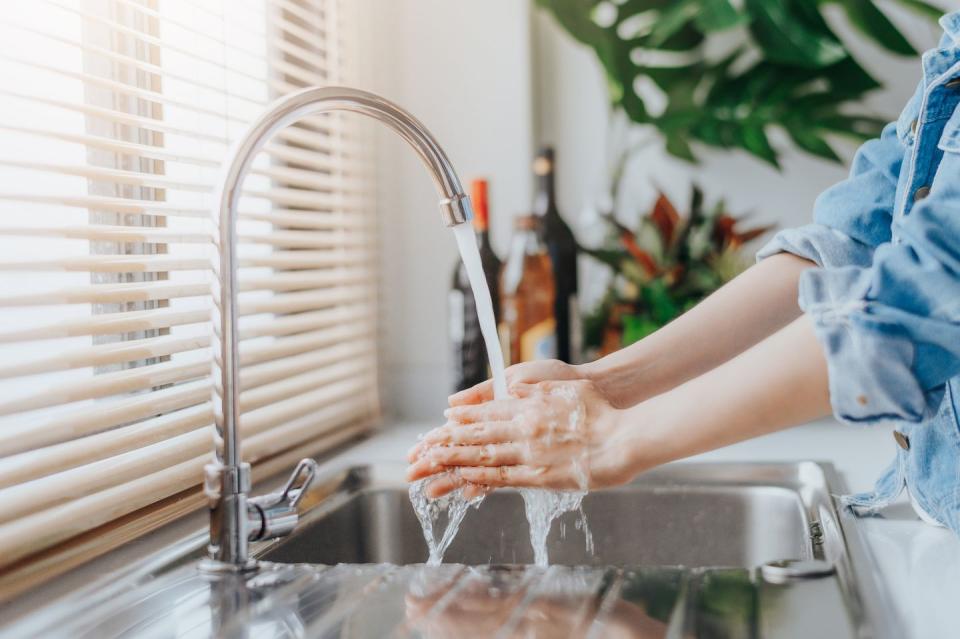Exactly When and How to Wash Your Hands to Kill Germs, According to Doctors

Every cold and flu season, doctors never fail to remind us that one of the best defenses against the common cold, flu, and other illnesses—like the current coronavirus pandemic—is as simple as it gets: washing your hands.
But believe it or not, one study from Michigan State University found that only 5 percent of 3,749 people washed their hands long enough to kill germs after using the bathroom. Even worse: 33 percent didn’t use soap and 10 percent didn’t bother washing their hands at all. And before meals? People fail to wash their hands properly 97 percent of the time, according to 2018 research from the U.S. Department of Agriculture.
While it seems like no biggie, even a quick rinse leaves you pretty germy, explains microbiologist Donald Schaffner, Ph.D., professor of food science at Rutgers University. Your hands can be contaminated with millions of pathogens (a single gram of poop can contain one trillion germs!) and even one microorganism can cause illness.
So next time you head to the sink, follow these guidelines closely to keep your hands squeaky clean—your body will thank you.
How to wash your hands correctly

First, get your hands wet.
Wet your hands under clean running water. Despite what you’ve heard, hot water isn’t your only option. “There’s no difference in cleaning power whether the water is 60°F (that’s cold), 80°F (pretty comfortably warm), or 100°F,” says Schaffner. If you can tolerate hot water for only three seconds, it’s completely okay to switch to a cooler temperature so you can keep your hands in the H2O longer.
Then, lather up.
That soft, gooey bar soap may look as if it’s hosting a germ field day, but any soap is better than none. The Centers for Disease Control and Prevention (CDC) says it doesn’t matter if you use liquid or bar soap at home or in public places—both do the job, as does foam soap, an aerated version of the liquid variety.
Get to scrubbing.
It’s the time your hands spend under the faucet that really matters, says Schaffner. How long should you wash your hands? His lab tested washes of different lengths and found that 20 seconds was more effective than five seconds, so go for at least 20 (or the amount of time it takes to hum “Happy Birthday” from beginning to end twice.) Once you’ve lathered up for long enough, rise your hands thoroughly under clean, running water.
Dry your hands properly.
A recent study from UConn Health found that after people held clean hands under a dryer for a minute, new bacteria could wind up on hands. The dryers stir up bacteria already in the bathroom, depositing some of it on once-clean mitts. But don’t freak out: “The vast majority of bacteria are not likely to be harmful to someone with a working immune system,” says study coauthor Thomas Murray, M.D., Ph.D., associate professor at the Yale University School of Medicine in the Department of Pediatrics, Section of Infectious Disease. Bottom line? If there’s a towel option, that’s a good first choice.
When should you wash your hands?
The CDC says certain situations should always be followed by proper hand washing, including the following:
Before, during, and after preparing food
Before eating food
Before and after caring for someone at home who is sick with vomiting or diarrhea
Before and after treating a cut or wound
After using the toilet
After changing diapers or cleaning up a child who has used the toilet
After blowing your nose, coughing, or sneezing
After touching an animal, animal feed, or animal waste
After handling pet food or pet treats
After touching garbage
In general, if your hands feel dirty—say, you just got home from work after taking public transportation or picking up groceries—it doesn’t hurt to give them a good wash.
Hand soap vs. hand sanitizer: Which is more effective?
If your hands are visibly dirty, old-school soap and water is the way to go, because the action of rubbing and rinsing dislodges bacteria and viruses. “Hand sanitizers must contact germs to damage and kill them,” and dirt can be a barrier, says David Berendes, Ph.D., epidemiologist with the Waterborne Disease Prevention Branch of the CDC.
[Find 52 weeks of tips and motivation, with space to fill in your mileage and favorite routes, with the Bicycling Training Journal.]
But if soap and water aren’t available and your hands aren’t filthy, does hand sanitizer work? Yes, an alcohol-based sanitizer that contains at least 60 percent alcohol can do the trick in a pinch. Cover all surfaces of your hands, and keep rubbing until they’re dry (don’t wipe it off!).
Additional reporting by Alisa Hrustic
You Might Also Like